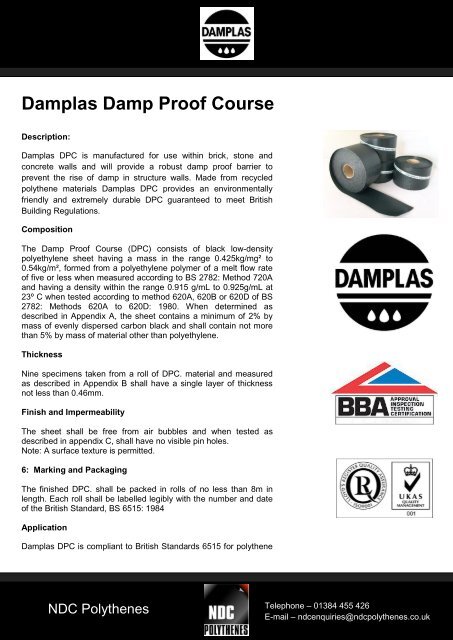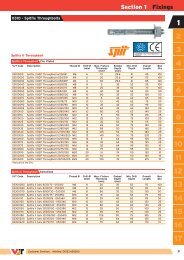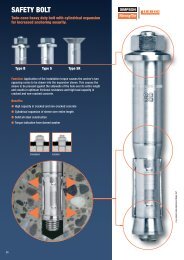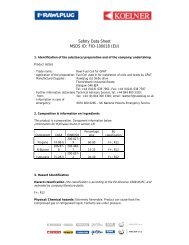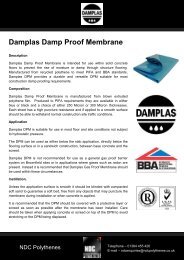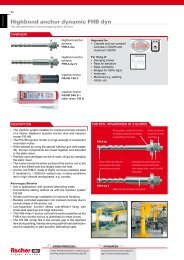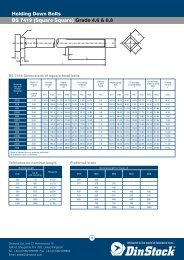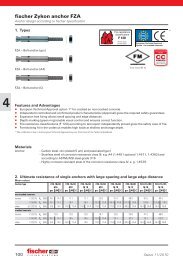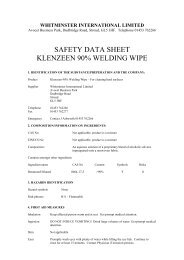Damplas Damp Proof Course
Damplas DPC data sheet - NDC Polythenes
Damplas DPC data sheet - NDC Polythenes
You also want an ePaper? Increase the reach of your titles
YUMPU automatically turns print PDFs into web optimized ePapers that Google loves.
<strong><strong>Damp</strong>las</strong> <strong>Damp</strong> <strong>Proof</strong> <strong>Course</strong><br />
Description:<br />
<strong><strong>Damp</strong>las</strong> DPC is manufactured for use within brick, stone and<br />
concrete walls and will provide a robust damp proof barrier to<br />
prevent the rise of damp in structure walls. Made from recycled<br />
polythene materials <strong><strong>Damp</strong>las</strong> DPC provides an environmentally<br />
friendly and extremely durable DPC guaranteed to meet British<br />
Building Regulations.<br />
Composition<br />
The <strong>Damp</strong> <strong>Proof</strong> <strong>Course</strong> (DPC) consists of black low-density<br />
polyethylene sheet having a mass in the range 0.425kg/mg² to<br />
0.54kg/m², formed from a polyethylene polymer of a melt flow rate<br />
of five or less when measured according to BS 2782: Method 720A<br />
and having a density within the range 0.915 g/mL to 0.925g/mL at<br />
23º C when tested according to method 620A, 620B or 620D of BS<br />
2782: Methods 620A to 620D: 1980. When determined as<br />
described in Appendix A, the sheet contains a minimum of 2% by<br />
mass of evenly dispersed carbon black and shall contain not more<br />
than 5% by mass of material other than polyethylene.<br />
Thickness<br />
Nine specimens taken from a roll of DPC. material and measured<br />
as described in Appendix B shall have a single layer of thickness<br />
not less than 0.46mm.<br />
Finish and Impermeability<br />
The sheet shall be free from air bubbles and when tested as<br />
described in appendix C, shall have no visible pin holes.<br />
Note: A surface texture is permitted.<br />
6: Marking and Packaging<br />
The finished DPC. shall be packed in rolls of no less than 8m in<br />
length. Each roll shall be labelled legibly with the number and date<br />
of the British Standard, BS 6515: 1984<br />
Application<br />
<strong><strong>Damp</strong>las</strong> DPC is compliant to British Standards 6515 for polythene<br />
NDC Polythenes<br />
Telephone – 01384 455 426<br />
E-mail – ndcenquiries@ndcpolythenes.co.uk
DPC. It is Suitable for withstanding a compressive load of up to 2.5<br />
N/mm 2 as long as no lateral load is applied.<br />
The DPC can be used in both vertical and horizontal applications to<br />
restrict the movement of upward and horizontal moving water within<br />
structure walls.<br />
<strong><strong>Damp</strong>las</strong> DPC is unsuitable for use in applications that places high<br />
sheer stress on the DPC, such as restraining walls or high flexible<br />
stress, such as freestanding walls and parapets.<br />
The DPC should not be used to restrict the flow of downwards<br />
moving water such as above lintels or within cavity walls.<br />
Suitable for use all year round this DPC is a highly versatile product<br />
and is subject to stringent quality controls to meet all British<br />
Standards.<br />
Installation:<br />
Installation should be according to the code of practice CP102:1973<br />
and normal DPC good practice procedures set in BS 5628 should<br />
be followed.<br />
Some brief guidelines on how to use the DPC are supplied below.<br />
For external walls <strong><strong>Damp</strong>las</strong> DPC should be applied 150mm above<br />
the adjoining surface and should be linked with the DPM in solid<br />
floors. The DPC should be applied to a fresh bed of mortar,<br />
completely free of projections that may puncture the material or<br />
impede the DPC from lying flat. When joining two pieces of DPC<br />
they should be lapped over each other by at least 100mm.<br />
For internal walls, DPC should be installed at the base of load<br />
bearing walls and linked with any adjoining DPM. The DPC should<br />
be at least the width the partition it is applied to and lapped by at<br />
least 100mm when two DPCs are joined.<br />
NDC Polythenes<br />
Telephone – 01384 455 426<br />
E-mail – ndcenquiries@ndcpolythenes.co.uk


